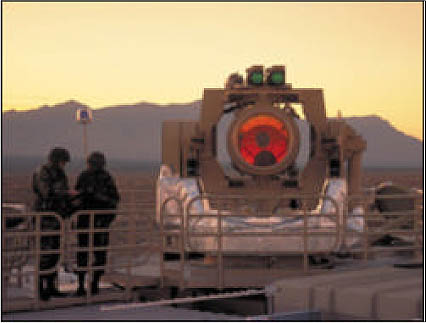The Tactical High-Energy Laser (THEL) laser illuminator can engage up to 60 nearly-simultaneous threats at a range of up to five kilometers, while maintaining a near-100 percent rate of success.
Although the system, located at the U.S. Army Missile Range at White Sands, NM, has been successfully tested against short-range Katyusha rockets, the unspecified target missile, was described by U.S. contractor Northrop Grumman as "representative of threats faced by U.S. and Israeli forces," posed a much more sophisticated challenge by presenting a target moving at more than twice the speed, three-times the altitude and significantly more mass than the MTHEL system has faced so .
The MTHEL system grew out of the larger stationary Tactical High-Energy Laser program initiated by the Clinton Administration in 1996 to develop a joint U.S.-Israeli system aimed at providing battlefield missile defense via focused, high-powered laser beams. It was designed to use existing laser-generation; fire-control; and command, control, communications and information (C3I) technology to produce an effective low-cost defense against short- and medium-range artillery, rocket and ballistic missile threats.
The Pentagon and the Israeli Ministry of Defense have spent nearly $300 million since development began eight years ago. Once fielded, MTHEL is expected to cost approximately $3,000 per use - slightly less than a single Mk84 2,000lb "dumb" bomb.
Although the system is not likely to meet its original target of initial operational capability in the year 2007, MTHEL could be deployed and operational before 2010, assuming that no significant delays or difficulties are encountered in future testing.
Although the current testbed is stationary, the first-generation operational system will consist of three large vehicles to house the laser and power generation units; fire-control and tracking radar; and command and control systems, the second-generation system is intended to equip a modified Humvee truck.
Prior to its latest test, the stationary MTHEL testbed had destroyed 28 Katyusha rockets and five artillery shells in single- and multiple-engagement tests since testing began in 2000. With the recent test proving the effectiveness of MTHEL against larger threats, construction is expected to begin soon of the first full-scale prototype.
 In a test conducted recently, the Mobile Tactical High-Energy Laser (MTHEL), a joint American-Israeli ballistic missile defense (BMD) project, destroyed a large, high-speed ballistic missile armed with a live-warhead in what is the most complicated and realistic test yet of a laser-based missile defense system.
In a test conducted recently, the Mobile Tactical High-Energy Laser (MTHEL), a joint American-Israeli ballistic missile defense (BMD) project, destroyed a large, high-speed ballistic missile armed with a live-warhead in what is the most complicated and realistic test yet of a laser-based missile defense system.